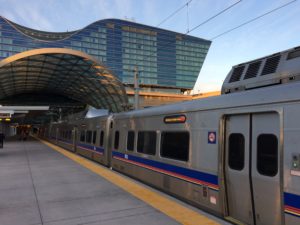The Importance of Airport-Downtown Rail Connections
Direct transit links are not only good for urban quality of life but improve regional competitiveness. They should be a no-brainer. Being able to land in a city and board a train with assurance you’ll be downtown in a fixed amount of time provides peace of mind for residents, tourists and businesspeople alike. A pleasant and even scenic journey bolsters this experience, and makes a powerful first impression that can boost investment.
On a recent trip to Denver I finally got to experience the long-awaited A Line, which opened in 2016. Having grown tired of the long drive in to the city over many years of visiting, it was wonderful to board a train at Denver Airport (DEN) and arrive at Union Station 37 minutes later. At 15 minute intervals, you never have to wait long, and the service is reliable and comfortable. The $10.50 fare is a bit steep, but tolerable. Arriving at Union Station on a busy Saturday evening to have a drink at The Cooper Lounge, overlooking the main hall, is a beautiful thing. It makes it seem like Denver has its act together.
LaGuardia (LGA) is the most notorious airport in the United States when it comes to transit connections to the center city, although it is hardly the worst statistically. The website FiveThirtyEight posted a 2015 article discussing travel times from airports to downtowns. Notably, only four American cities have a transit system that gets you there by train faster than a car. Interestingly, my very own Minneapolis/St. Paul International (MSP) scored highest on the FiveThirtyEight chart with a 30-minute train journey from terminal to downtown, which beats the 35-minute drive. Denver’s A Line would today be ranked much better on an updated version of the list.
Jarrett Walker at Urban Transit wrote about the keys to great airport transit service in 2016. A few relevant things pop out to me. One is modal share of air travelers using transit should be one-third to one-half or more, provided a well-connected airport like London Heathrow (LHR) at 36% or Hong Kong (HKG) at 63%. Modal share is a pretty good indicator of overall effectiveness of the airport transit line (a quick survey found that there isn’t a North American airport that even approaches a 20% modal share). Second is total travel time matters, and airport to downtown times of 30 minutes for Minneapolis, Washington Reagan (DCA), Atlanta (ATL), San Diego (SAN), and Boston (BOS) are really important. Third, it is really important for the airport transit line to also provide access to other major regional destinations besides downtown.
With Denver, I’ve now taken transit from numerous airports to destinations in their respective cities, often downtown. Perhaps my favorite journey is Boston, only it’s not by train, it’s by boat. If you’ve never done so, I highly recommend arriving in Boston, weather permitting, and taking a Water Taxi from the airport. The fresh air will do you some good! Life’s about the journey, I guess.
The list of transportation infrastructure that impact quality of life in cities is long and varied, but a quick, reliable transit link from airport to downtown is pretty high on that list. It enables residents, visitors, businesspeople and employees to access both airport and downtown with ease. This helps regional economies function but also gives the impression that cities have their act together. As a resident and business owner in Minneapolis, I can say that light rail service from MSP to our downtown for the past 15 years is a huge boost to our regional economy and quality of life.
No Comments »
No comments yet.
RSS feed for comments on this post. TrackBack URI
Leave a comment
Line and paragraph breaks automatic, e-mail address never displayed, HTML allowed: <a href="" title=""> <abbr title=""> <acronym title=""> <b> <blockquote cite=""> <cite> <code> <del datetime=""> <em> <i> <q cite=""> <s> <strike> <strong>


